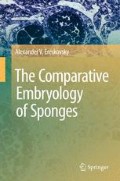Abstract
Representatives of the class Hexactinellida, commonly called glass sponges, are very variable in shape. They may be tubular, cup-shaped, lumpy, branching, or lobulate (color plate III); only encrusting forms are lacking. Hexactinellid sponges have silicate triaxial spicules or their derivatives. Typically, spicules are represented by hexactins, with three axes crossing at regular angles. A loss of one or more rays results in pentactins, tetractins (stauractins), triactins (tauactins), and diactins; rarely, monactins also occur (Fig. 2.1). The axial filament of the spicule resides in a quadrangular cavity. Spicules are divided into micro- and macroscleres; the latter, often fused together, form rigid skeletal lattices (Fig. 2.2). Dense spongin or nonspicular skeletons do not occur. Living tissues of glass sponges are syncytial and consist of the dermal and the atrial membrane, the internal trabecular reticulum enclosing cellular components of the sponge, and flagellated chambers (Figs. 24, 25). Separate nucleated cells, which are situated in syncytial pockets or capsules, may be connected by specialized contacts, porous plugs. Large eurypilous flagellated chambers are organized according to leuconoid type. All glass sponges are ovoviviparous, with the trichimella larva.
Access this chapter
Tax calculation will be finalised at checkout
Purchases are for personal use only
References
Boury-Esnault N, Vacelet J (1994) Preliminary studies on the organisation and development of a hexactinellid sponge from a Mediterranean cave, Oopsacas minuta. In: van Soest RWM, van Kempen TMG, Braekman JC (eds) Sponges in time and space. Balkema, Rotterdam/Amsterdam
Boury-Esnault N, Efremova SM, Bézak C, Vacelet J (1999) Reproduction of a hexactinellid sponge: first description of gastrulation by cellular delamination in the Porifera. Invert Rep Dev 35:187–201
Ijima I (1901) Studies on the Hexactinelida, Contribution I. (Euplectellidae). J Coll Sci Imper Univ Tokyo 15:1–299
Leys SP, Cheung E, Boury-Esnaulty N (2006) Embryogenesis in the glass sponge Oopsacas minuta: formation of syncytia by fusion of blastomeres. Integr Comp Biol 46:104–117
Leys SP, Mackie GO, Reiswig HM (2007) The biology of glass sponges. Adv Mar Biol 52:1–145
Mackie GO, Lawn ID, Pavans de Ceccatty M (1983) Studies on hexactinellid sponges. II. Excitability, conduction and coordination of responses in Rhabdocalyptus dawsoni (Lambe 1873). Phil Trans Roy Soc Lond Ser B 301:401–418
Mehl D (1996) Phylogenie und Evolutionsökologie der Hexactinellida (Porifera) im Paläozoikum. Geol Paläontol Mit Innsbruck 4:1–55
Okada Y (1928) On the development of a hexactinellid sponge, Farrea sollasii. J Fac Sci Imper Univ Tokyo 2:1–27
Rieger R, Weyrer S (1998) The evolution of the lower Metazoa: evidence from the phenotype. In: Müller WEG (ed) Progress in molecular and subcellular biology, vol 21. Springer, Berlin
Schulze FE (1880a) On the structure and arrangement of the soft parts in Euplectella aspergillum. Trans R Soc Edinb 29:661–673
Tardent P (1978) Coelenterata, Cnidaria. In: Seidel F (ed) Morphogenese der Tiere, erste Reihe, Deskriptive Morphogenese. Lieferung 1, A-I. Gustav Fischer Verlag, Jena
Tuzet O (1973b) Hexactinellides ou hyalosponges. Spongiaires In: Grass PP (ed) Traite de Zoologie. T. 1. N 3, Maison Cie, Paris
Author information
Authors and Affiliations
Corresponding author
Rights and permissions
Copyright information
© 2010 Springer Science+Business Media B.V.
About this chapter
Cite this chapter
Ereskovsky, A.V. (2010). Development of Sponges from the Class Hexactinellida Schmidt, 1870. In: The Comparative Embryology of Sponges. Springer, Dordrecht. https://doi.org/10.1007/978-90-481-8575-7_2
Download citation
DOI: https://doi.org/10.1007/978-90-481-8575-7_2
Published:
Publisher Name: Springer, Dordrecht
Print ISBN: 978-90-481-8574-0
Online ISBN: 978-90-481-8575-7
eBook Packages: Earth and Environmental ScienceEarth and Environmental Science (R0)

